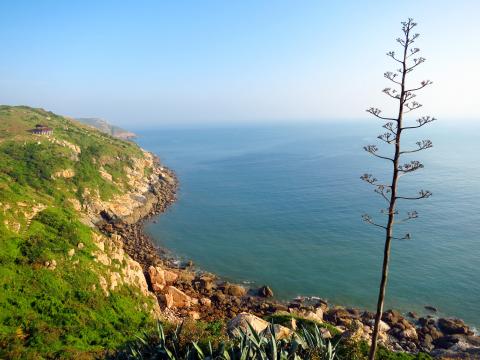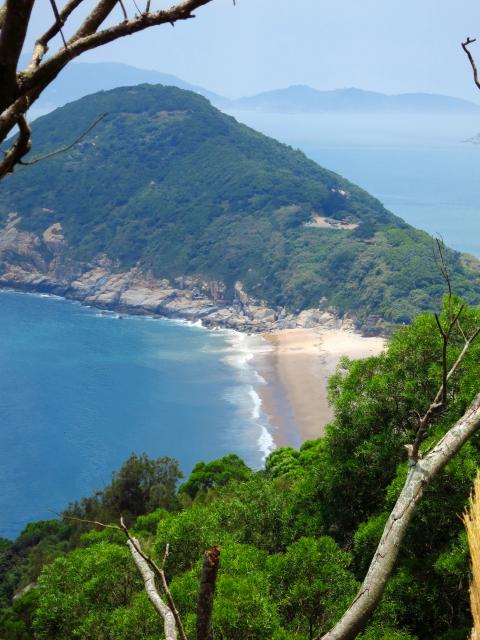Beigan (北竿), Matsu’s second largest island, is best known for Qinbi (芹壁), a beautiful old village of stone houses clinging to a steep hillside beside the ocean.
Qinbi is Matsu’s biggest tourist attraction, and the main reason why most Taiwanese visitors go to Matsu. Qinbi is a compulsory stop on any visit to Beigan, but as always on these enchanted islands, there are plenty of less well-known natural and man-made attractions to enjoy, including an amazing underground harbor, Matsu’s best museum, as well as grander and wilder scenery than nearby Nangan Island (南竿島).


Photo: Richard Saunders
While you should visit at least one other island in the group to get a proper feel for life in this unique chain of islands, Beigan is as good a place as any to enjoy both the great outdoors and to learn a bit about Matsu’s turbulent past.

The easiest way to reach Beigan is by plane from Taipei, but I prefer to arrive from neighboring Nangan by boat (15 minutes), which better sets the scene for Beigan’s very slow, relaxed pace of life. Boats arrive at Baishi Harbor (白沙港) in the south of the island, and scooters can be rented from several places here. Take care, however, when hiring a scooter on any of Matsu’s islands. Happily, the scooters are generally of far better quality now than just a few years ago, when the average one was old and battered, and often had brakes that were borderline dangerous on Matsu’s sometimes very steep hills.

The problem nowadays is that there’s a lively (even cut-throat) competition between scooter hire outfits and hotels. If you already have accommodation booked when you arrive on the island, call the hotel ahead to arrange a lift, and then hire the scooter direct from them, to avoid possible conflicts later. Be sure to always wear your scooter helmet when driving. On my last visit earlier this month, a hotel owner warned me that frustrated scooter hire outfits, fed-up with lost business, were reporting tourists riding without helmets to the police, and getting them fined.
CRUISING THE COAST
Leaving the harbor by the coast road heading north, a long, mountainous sweep of China’s coast is clearly visible in clear weather. Pass Banli Beach (?里海灘), Beigan’s largest, but strewn with small rocks, and a little further along the coast is Beihai Tunnel (北海坑道), dug (like its counterparts on Nangan and Dongyin islands) in an amazingly short time with nothing more than dynamite, simple tools and a huge amount of blood sweat and tears.
Over a hundred soldiers died during the construction of the tunnel, and the area is said to be haunted. It’s a very impressive sight, but was unfortunately “temporarily” closed a year or two back, apparently because the roof is unstable. Leaving Banli, the main road climbs high above the ocean. Take a left at the junction and the road climbs steeply to the top of Mount Bi (壁山), the highest point on the Matsu islands at 298 meters. A viewing platform beside the road gives a magnificent bird’s eye panorama over the eastern half of Beigan.
Below Mount Bi, on the west coast of the island, the famous, much photographed old village of Qinbi (established during the Qing Dynasty) is the best preserved and most complete stone house village in Matsu. It’s best approached from the south, where the first view of it is utterly charming. Unfortunately, some thoughtless development (such as the hideous tile-walled high school buildings) has spoiled the beauty of the scene, and some new faux-traditional impostors (built of brick, with a thin facing of stone) were built a couple of years ago, presumably to satisfy the growing demand for homestays in the village.
Despite this, Qinbi is the nicest place to stay on the island, with a number of homestays (book early). If the homestays are full, try at least to enjoy a leisurely drink or snack at one of the village’s two cafes, which both have large, open terraces. From here, the view of the granite houses tumbling down the hillside to the still, blue-green waters of the bay and the low dome of Turtle Island just offshore, is quite magical. Look further out to sea, and the coast of China is visible in the distance.
THE VILLAGE OF TANGQI
Next to the island’s airport, Tangqi (塘岐), is Beigan’s largest village, with the best selection of accommodation, eating options and shops. A couple of eateries in the main street sell Matsu’s famous fish noodles (魚麵; flaked fish is incorporated into the noodle dough), but although eating a bowl is de rigueur for local tourists, they’re nothing special.
Pass through the tunnel under the airport runway, and cross the long sandbar that joins Beigan to little Houao Islet (后沃). Despite being rudely bisected by the airport, the remaining sweep of sugar sand is a great place for a paddle.
Passing through Matsu’s only traffic light, the road climbs steeply onto the heights of Houao. At the top is the War and Peace Memorial Park (軍事和平紀念公園). Turn left and follow the road to Stronghold no. 6, which lies in a magnificent setting at the northern tip of the island. The tunnels of the stronghold wind through the rock, emerging at several gun emplacements looking out over the sea. From the end, sets of steps descend towards the rocky foreshore, and climb back up the cliffs. Further south, the War and Peace Memorial Park Exhibition Hall (戰爭和平紀念公園主題館) gives a detailed rundown (in English) of the island’s tumultuous recent history.
The exhibition hall is at the trailhead of one of Matsu’s finest hikes, the Luoshan Nature Trail (螺山自然步道). This short walk (less than an hour each way) has magnificent views, and ends at an observation platform overlooking the channel between Houao and Luoshan islets, and a small rock stack known as Confucius on the Sea. This wild and beautiful spot is one of Beigan’s most exhilarating spots, and a quiet place to lap up a view that encompasses the whole length of Beigan Island.
Richard Saunders is a classical pianist and writer who has lived in Taiwan since 1993. He’s the founder of a local hiking group, Taipei Hikers, and is the author of six books about Taiwan, including Taiwan 101 and Taipei Escapes. Visit his Web site at www.taiwanoffthebeatentrack.com.

This is the year that the demographic crisis will begin to impact people’s lives. This will create pressures on treatment and hiring of foreigners. Regardless of whatever technological breakthroughs happen, the real value will come from digesting and productively applying existing technologies in new and creative ways. INTRODUCING BASIC SERVICES BREAKDOWNS At some point soon, we will begin to witness a breakdown in basic services. Initially, it will be limited and sporadic, but the frequency and newsworthiness of the incidents will only continue to accelerate dramatically in the coming years. Here in central Taiwan, many basic services are severely understaffed, and

Jan. 5 to Jan. 11 Of the more than 3,000km of sugar railway that once criss-crossed central and southern Taiwan, just 16.1km remain in operation today. By the time Dafydd Fell began photographing the network in earnest in 1994, it was already well past its heyday. The system had been significantly cut back, leaving behind abandoned stations, rusting rolling stock and crumbling facilities. This reduction continued during the five years of his documentation, adding urgency to his task. As passenger services had already ceased by then, Fell had to wait for the sugarcane harvest season each year, which typically ran from

It is a soulful folk song, filled with feeling and history: A love-stricken young man tells God about his hopes and dreams of happiness. Generations of Uighurs, the Turkic ethnic minority in China’s Xinjiang region, have played it at parties and weddings. But today, if they download it, play it or share it online, they risk ending up in prison. Besh pede, a popular Uighur folk ballad, is among dozens of Uighur-language songs that have been deemed “problematic” by Xinjiang authorities, according to a recording of a meeting held by police and other local officials in the historic city of Kashgar in

The People’s Republic of China (PRC) was out in force in the Taiwan Strait this week, threatening Taiwan with live-fire exercises, aircraft incursions and tedious claims to ownership. The reaction to the PRC’s blockade and decapitation strike exercises offer numerous lessons, if only we are willing to be taught. Reading the commentary on PRC behavior is like reading Bible interpretation across a range of Christian denominations: the text is recast to mean what the interpreter wants it to mean. Many PRC believers contended that the drills, obviously scheduled in advance, were aimed at the recent arms offer to Taiwan by the